Rebecca Ballard
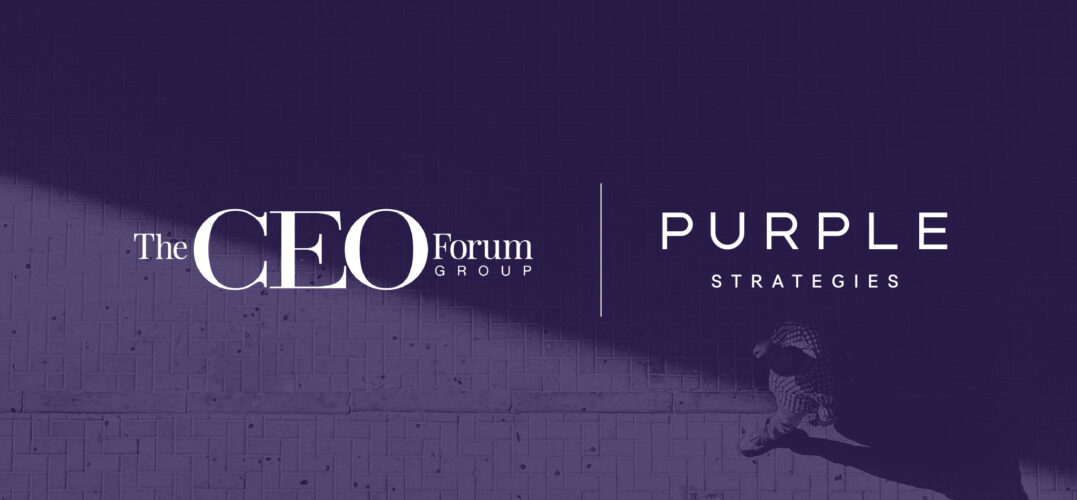
Posted on
February 1, 2024
3 Min. Read
Author
Purple Strategies
AI and Paradigm Shifts on the Minds of Healthcare CEOs
Purple Strategies is the thought leadership partner of The CEO Forum Group and Transformative CEO Summit series, featuring CEOs of leading companies discussing creative ways to solve today’s most pressing challenges. The Transformative CEO Summit on Healthcare brought together CEOs in the industry to explore future models of healthcare, the role of leadership, culture and supply chain agility in healthcare transformation, and the impact of AI.
As the old year gave way to the new, healthcare executives gathered for the third annual Transformative CEO Summit on health to discuss some of the most pressing challenges in the space. Here are four topics that are on the minds of healthcare CEOs as 2024 begins.
(1) AI’s rapid advancement is changing the face of healthcare for both patients and medical professionals.
While AI has been in use in healthcare for decades, industry leaders at December’s Summit – including healthcare practitioners, administrators, and partners who serve this industry – expect these technologies to expand exponentially in the coming years on a range of applications – from reducing doctors’ research time and administrative work and addressing staff burnout, to advancements in behavioral health and improved disease diagnoses and treatment recommendations. Notwithstanding their concerns about setting proper boundaries for AI in healthcare (more on this below), experts believe that AI’s integration into healthcare operations will continue to revolutionize healthcare, leading to improved efficiency, better patient care, and significant progress in addressing critical health issues.

(2) The future of healthcare will revolve around personalized care and a deeper integration of AI in home-based services.
Leaders see healthcare moving toward virtual and home-based services, a major democratizing shift that is patient-driven and that will increasingly rely on technology for support and advancement. The goal is to make healthcare more inclusive, customized, and responsive. In addition to developing and embracing the technologies to support this transition, the move toward virtual/home-based healthcare will also require building capability and agility in the supply chain of healthcare products and services.

(3) AI should augment, not replace, the human element in healthcare.
Noting the broader fears some people have over AI’s potential to displace human-driven work and processes, industry leaders stress that effective integration of AI in the healthcare space should prioritize augmenting human involvement, not substituting it entirely. Human oversight of AI-driven processes will be necessary to maintain accuracy, transparency, and accountability where human judgment and decision making are required – particularly around as yet unresolved privacy and security concerns. The experts discussed that as this technology is rapidly developed and as those in this field race to deploy these technologies, there is an imperative for leaders to reflect on the applications and limitations of using technology in this space, especially as regulation struggles to keep pace.

(4) The greater focus on preventive care stems from a shift in healthcare paradigms toward proactive and patient-centric approaches.

The future of health will continue the shift in focus from sick care to well care. Experts at the Summit discussed the degree to which preventive care is often more cost-effective for all involved – by focusing on early detection and intervention, healthcare systems can potentially reduce the financial burden associated with treating chronic illnesses in later stages. Beyond the financial benefit, early identification and management of health issues contribute to better patient outcomes, often helping avoid the progression of diseases and resulting in improved quality of life and increased lifespan. The integration of technologies like AI allows for more personalized and predictive healthcare including the ability to analyze health data, identify risk factors, and enable timely interventions. A preventive care model also aligns with a patient-centered approach, focusing on individual wellbeing and empowering individuals to actively participate in their health.

Explore more from Purple Strategies in the Transformative CEO Summit series:
CEOS PIVOT FROM HEALTH CRISIS TO HUMAN CONNECTION | 2021 (READ)
CEOS STRIVE TO BUILD A BETTER WORKPLACE POST-PANDEMIC | 2021 (READ)
CEOS SHARE VIEWS ON ESG CHALLENGES AND OPPORTUNITIES | 2021 (READ)
CEOS EMBRACE EXPECTATION TO GO BEYOND CORPORATE INTO SOCIETAL LEADERSHIP | 2022 (READ)
CEOS FOSTER THE DYNAMIC PULL AT THE HEART OF BREAKTHROUGH INNOVATION | 2022 (READ)
CEOS UNLEASH THE POWER OF THE INDIVIDUAL | 2022 (READ)
PRIORITIZING PURPOSE IN THE NEW ERA OF CAPITALISM | 2023 (READ)
CEOS EMBRACE A MORE PUBLIC ERA OF LEADERSHIP | 2023 (READ)
CEOS EMBRACE RISK TO REVEAL COURAGE IN THE FACE OF CHANGE | 2023 (READ)

Posted on
December 11, 2023
3 Min. Read
Author
Purple Strategies
CEOs Embrace Risk to Reveal Courage in the Face of Change
What would you do if you weren’t afraid? Four ways today’s CEOs are breaking out of their comfort zone.
Purple Strategies is the thought leadership partner of The CEO Forum Group and Transformative CEO Summit series, featuring CEOs of leading companies discussing creative ways to solve today’s most pressing challenges.
As leaders, CEOs are constantly being asked to lead in situations that are outside of their comfort zone and present considerable risk. CEOs need to make daily decisions about issues like rapid advances in truly transformative technology like AI, how to manage ongoing geopolitical and macroeconomic headwinds, and meeting the ever-increasing expectations of key stakeholders. How leaders respond during these times can set up opportunities that benefit the business and its employees in the long-term, change an industry for the better, and even drive society forward. Meeting the moment requires courage in the face of uncertainty.
From discussions among CEOs at The CEO Forum Group’s latest Transformative CEO Summit, Purple Strategies identified concrete actions that leaders from across industries are taking that create the conditions to display courageous leadership in the face of change.
(1) Build and empower a team
While CEOs are expected to own and lead their vision, transformative leaders acknowledge they are not doing it alone. The pursuit of that vision is a dynamic process that involves fostering collaboration, a shared sense of purpose, and reliance on a trusted team to provide courage and support.
First and foremost, stresses Steve Jones, Global Chairman & CEO of Allied Universal, is the importance of building a team of leaders with a mix of talent from inside the company/industry and outside of these spaces. Assembling a diverse and talented group with varied skills and experiences – including those within and outside the company – encourages more effective leadership over assembling a leadership team solely from within the organization, which can pose challenges such as limiting innovation or the development of an insular, exclusive culture.
That CEO focus on empowerment expands beyond the composition of a leadership team to a company’s broader culture as well. Nearly half of Summit CEOs surveyed selected collaboration and empowering team members to use their strengths and be leaders as the most important area to prioritize to improve the culture of their organization.

(2) Cultivate your own confidence and character
CEOs often cultivate their confidence and character through courageous decision making. Every CEO at the Summit reported that they make decisions outside their comfort zone. Six in 10 said they do so frequently.
CEOs tap into different sources to drive that confidence for making tough decisions. Xavier Mufraggi, CEO of SVN International Corp., cites data as a source of confidence: While making a decision that might not be popular takes courage, he says, using data to back up results creates more confidence in sticking with a choice. Mara McNeill, CEO of Toyota Financial Savings Bank, notes her very appointment to the role as a source from which she derives confidence: “If I was put in this position, I’m supposed to be here.”
Scenario planning is another place CEOs develop confidence for their decisions. Creating a plan for how to operate in difficult situations, even in scenarios that might be unpredictable, is a key to successful leadership.
(3) Foster psychological safety and a growth-mindset culture
CEOs play a crucial role in developing an organization’s capacity to provide employees with psychological safety, which is critical to a willingness to take risks and contribute ideas. One way CEOs foster that needed safety is by creating a culture of consistently asking for feedback, starting with leadership. Modeling that behavior reduces stress on those who may feel uncomfortable sharing feedback unprompted and helps ensure important feedback is able to be received.
Another step CEOs are taking is putting developing leaders in new and challenging scenarios to help foster a culture of experimentation where all ideas are heard. Marc Miller, CEO of Universal Health Services, has seen that a leader’s cross-training and exposure to things outside of their daily responsibilities creates a sense of empathy when working with others.
CEOs also advise that, to create an open employee culture, failure should be embraced as a means of learning and growing. Humility on the part of leaders and CEOs in admitting mistakes, showing a willingness to learn, and seeking feedback are all important in strengthening trust with employees and unlocking the growth mindset CEOs want to see in their organizations.
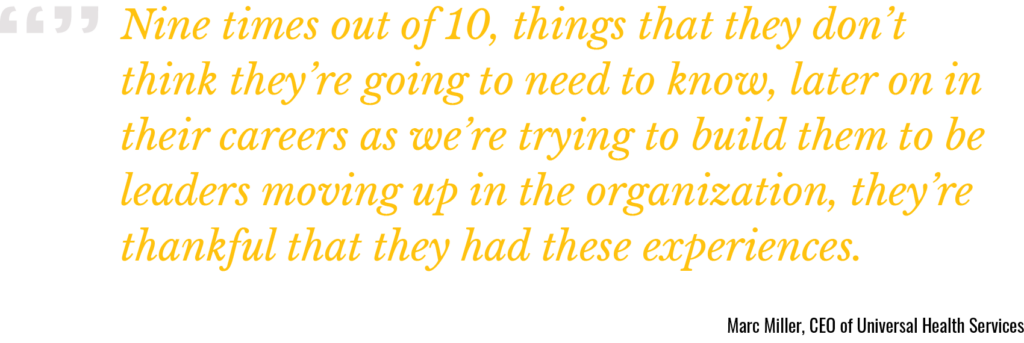
(4) Embrace continuous learning
Today’s modern leaders embrace continuous learning as a way to keep pace with – or ideally stay ahead of – change. AI adoption is an excellent current example of this in action. CEOs see AI as enabling businesses to analyze far more data than before, empowering leaders to use a data-driven approach to grow the business and stay ahead of industry changes.
Todd Simon, Chairman of Omaha Steaks, spoke of the benefits of AI in helping to upskill employees. His company is already using AI technology to scan sales calls to identify the highest performing call reps, which in turn saves the business time and money. AI can also identify gaps in trainings, skill sets and culture.
Rather than avoid AI out of a sense of fear or risk, courageous CEOs are eager to deepen their understanding of AI before facing changes: four in ten Summit CEOs report feeling that investing in education and training around AI is the best way to unlock the promise of AI within their organization. By proactively leveraging AI-driven capabilities, CEOs can integrate new and accelerated opportunities for continuous learning into their business.
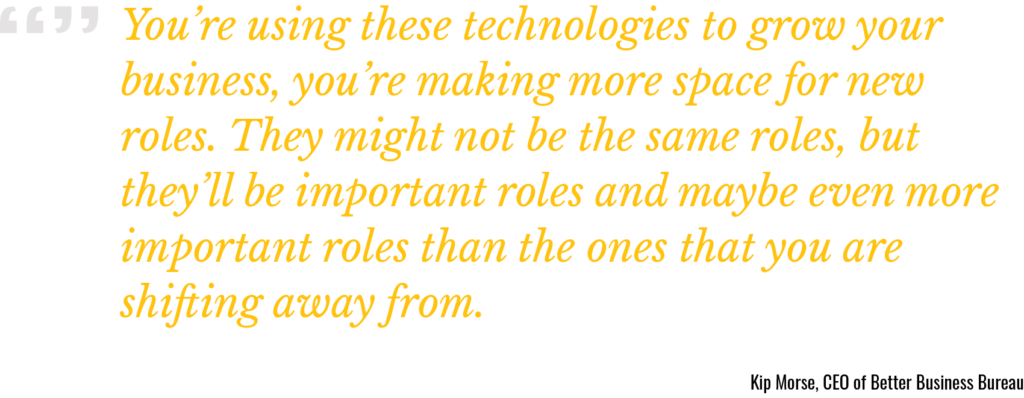
Explore more from Purple Strategies in the Transformative CEO Summit series:
CEOS PIVOT FROM HEALTH CRISIS TO HUMAN CONNECTION | 2021 (READ)
CEOS STRIVE TO BUILD A BETTER WORKPLACE POST-PANDEMIC | 2021 (READ)
CEOS SHARE VIEWS ON ESG CHALLENGES AND OPPORTUNITIES | 2021 (READ)
CEOS EMBRACE EXPECTATION TO GO BEYOND CORPORATE INTO SOCIETAL LEADERSHIP | 2022 (READ)
CEOS FOSTER THE DYNAMIC PULL AT THE HEART OF BREAKTHROUGH INNOVATION | 2022 (READ)
CEOS UNLEASH THE POWER OF THE INDIVIDUAL | 2022 (READ)
PRIORITIZING PURPOSE IN THE NEW ERA OF CAPITALISM | 2023 (READ)
CEOS EMBRACE A MORE PUBLIC ERA OF LEADERSHIP | 2023 (READ)

Posted on
September 7, 2023
3 Min. Read
Author
Purple Strategies
CEOs Embrace a More Public Era of Leadership
Four Aspects of the Chief Executive Role Gaining Visibility
Purple Strategies is the thought leadership partner of The CEO Forum Group and Transformative CEO Summit series, featuring CEOs of leading companies discussing creative ways to solve today’s most pressing challenges.
The role of CEO has evolved beyond leader and decision maker in the corner office to take on a more public persona that embodies how the company wants to show up in the marketplace and with employees. The shift from a more company-centric, internal focus to leading in the spotlight was a prevailing theme shared among CEOs at the latest Transformative CEO Summit in June.
CEO attendees shared four parts of their jobs that are attracting more exposure, and how they’re continuing to build and lead successful companies when all eyes are on them.
(1) The Human Behind the Title
CEOs describe the expectations they’re feeling from employees, investors and others to be more authentic, approachable and vulnerable while running their companies.
In her keynote remarks, Esi Seng, CEO of Tate’s Bakery, said her goal was to inspire a community of CEOs to leverage “the power of real.” As she described it, “That means admitting your mistakes, not knowing all the answers, making dad jokes, and letting people see your flaws.” Employees will reciprocate this behavior, she added, and the exercise will help the business by resulting “in meaningful discussions and questions that provoke change and elevate the thinking.”
Finding the right balance of leadership and accessibility can be a challenge, but CEOs who master the art of authenticity while leading their companies can earn tremendous trust and confidence in the process.
(2) The Business Roadmap

With the rise of employee activism, CEOs are required to be more transparent and proactive with their workforces than ever.
Lynn Tilton, CEO of MD Helicopters, described her views on leadership, “Your greatest responsibility is to take people on that journey with you, to lead from the front.” She highlighted why it is so critical for CEOs to communicate about where the company is and where it’s going, adding, “It is not about what you accomplish yourself. But how many lives are better because you did what you did.”
In a period of heightened interest in what companies are doing and where they are going, CEOs are turning toward transparency and openness to keep employees engaged in the company’s journey.
(3) The Mechanics of Creating Culture

With five generations now in the workforce, CEOs describe the need to more actively and intentionally build an inclusive culture. The things that historically drove in-office company culture – serendipitous moments and impromptu conversations – are less prevalent with remote work and distributed workforces. To strengthen culture now, CEOs have to be even more deliberate.
Giordano Albertazzi, CEO of Vertiv said of his experience, “It’s about being extremely intentional in driving the right culture or the desired culture given where the organization is… This is to the extent that I couldn’t fathom before I was in this current role, but you have to be relentless and very structured to make sure that that culture seeps through the organization.”
Culture is perhaps even more critical in a distributed and hybrid workforce, and the efforts CEOs are making to create strong ones are now more tangible and on display.
(4) The Leader’s POV on Emerging Technologies
Charged with steering their companies to a stronger future, CEOs have long needed to stay apprised of emerging technologies. However, what has changed is the expectations for them to communicate with key audiences about those technologies and their potential impacts. At this Transformative CEO Summit, the topic of artificial intelligence (AI) surfaced across discussion groups, with moderators and attendees seeking the CEOs’ perspectives on how they are thinking about the new technology and forecasting what it could mean for their industries.
While some cautioned against AI’s misuse, many CEOs described the promise they see from this emerging technology.
Adam von Gootkin, CEO of Highclere Castle Spirits, said, “By embracing AI, we can use the tool more effectively to tell our story and give people an immersive experience.”
Separately, Adam Goldstein, Executive Chairman of DLT Global, also added his support, “AI-related tools contain the opportunity to express who you are as a brand much better to customers and potential customers than anything that has existed up until now.”
CEOs are no strangers to identifying and evaluating new technologies. But this Summit suggests that they are being asked to do so sooner and even more publicly.

As the CEO role continues to evolve, what used to be unseen parts of their job are becoming more visible. Important audiences are expecting more insight from executives into their company strategy, culture, future-proofing of the organization, and even their own very humanness and flaws. To build trust and meaningful relationships with these stakeholders, CEOs are learning to embrace the spotlight and guide their businesses to success with even more openness and transparency.
To learn about other dynamics impacting the reputation landscape facing top executives, visit Futurecasting by Purple Strategies.
Explore more from Purple Strategies in the Transformative CEO Summit series:
CEOS PIVOT FROM HEALTH CRISIS TO HUMAN CONNECTION | 2021 (READ)
CEOS STRIVE TO BUILD A BETTER WORKPLACE POST-PANDEMIC | 2021 (READ)
CEOS SHARE VIEWS ON ESG CHALLENGES AND OPPORTUNITIES | 2021 (READ)
CEOS EMBRACE EXPECTATION TO GO BEYOND CORPORATE INTO SOCIETAL LEADERSHIP | 2022 (READ)
CEOS FOSTER THE DYNAMIC PULL AT THE HEART OF BREAKTHROUGH INNOVATION | 2022 (READ)
CEOS UNLEASH THE POWER OF THE INDIVIDUAL | 2022 (READ)
PRIORITIZING PURPOSE IN THE NEW ERA OF CAPITALISM | 2023 (READ)
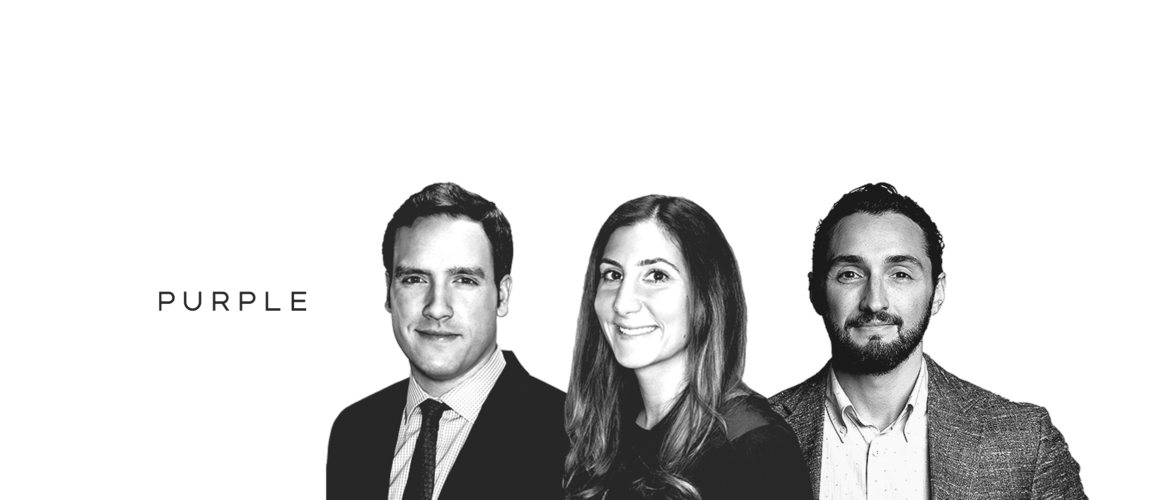
Posted on
August 28, 2023
3 Min. Read
Author
Purple Strategies
Purple Strategies Elevates Three To Partnership Group
Seasoned Purple client counselors, managing directors and leaders Stephen Smith, Ashley Gibaldi and Nate Byer have been named partners in the firm.
Building on recent steps to expand and strengthen its leadership structure amid continued growth, Purple Strategies is excited to announce that three long-time leaders at the firm have been added to its partnership group: Stephen Smith, Ashley Gibaldi, and Nate Byer.
“For 15 years, Purple has helped some of the world’s biggest brands protect and create enterprise value through strategic reputation management. Stephen, Ashley and Nate have been consistently and increasingly integral to developing strategy and delivering insights that guide our clients on that journey,” said Steve McMahon, Purple co-founder and CEO. “As founders, one of the great joys Alex and I have experienced is watching the next generation of Purple leaders develop into world class strategists and leaders in their own right. Today our clients could ask for no better partners than Stephen, Ashley and Nate.”

About Stephen Smith
As the leader of Purple’s Strategic Planning group, Stephen leverages his experience across health care, logistics, manufacturing and technology both for reputation renewal and for challenges in public affairs.
Stephen joined Purple in 2009 with a strong background in digital innovation. And he’s played a key role in transforming the company’s service offerings by integrating digital services into its core operations, reshaping how its campaigns are conceived and executed.
In his current role, Stephen dives deep into client engagements, crafting insights from primary research, and shaping innovative campaign activations. His ability to adapt to shifting business landscapes, dedication to proactive problem-solving, and commitment to producing high-quality work mirror the core values of Purple. Stephen’s background prior to Purple – working with Senators Bill Frist, Mitt Romney, and Lamar Alexander – ensures that his approach to corporate reputation accounts for both politics and policy.
Stephen graduated from Princeton, earning a Bachelor of Arts degree in politics and political theory.
“Seeing Stephen lead a debate or workshop about client strategy is a thing to witness and never gets old – his brilliance and love for solving complex challenges is on full display, and every client and colleague he works with is better because of it. His leadership of our new Strategic Planning group, and now as a firm partner, is an acknowledgement of the value he has added to our firm since its very beginning.” – Steve McMahon

About Ashley Gibaldi
Ashley serves as an indispensable senior counselor at Purple Strategies helping the world’s leading companies across industries build and protect reputational equity ahead of and during issues or crises.
She excels in transforming multifaceted data into actionable insights, grounding everything we do from strategic planning to identifying persuasive messaging to highly targeted activations. Prior to joining Purple in 2010, Ashley worked at Edison Research on the highly visible National Exit Polls for a consortium of major news networks like CNN, NBC and ABC.
Ashley’s work has allowed companies to navigate unique and challenging environments to achieve business and desired outcomes. She has experience leading engagements with companies navigating relationships with unionized workforces. Ashley’s impact goes beyond leading client solutions as she’s equally dedicated to leading and growing Purple’s talent.
“There’s a big difference between saying you are insights-driven and actually putting insights at the heart of your work, and Ashley does that as well as anyone. Her unwavering commitment to being led by insights and her role in developing that skill in others have made her a valued and trusted partner to clients and colleagues alike. She has a unique ability to ask the right questions and challenge assumptions in ways that make the work and those around her better. For years, Ashley has brought so much to our firm and to her clients, and that’s why we are so proud to elevate her to partner. She is an incredibly valuable new addition to our partnership group.” – Steve McMahon

About Nate Byer
Nate leads the planning and execution of complex reputation management and renewal programs for a wide range of Purple clients. As the head of the firm’s Client & Campaign Expertise Group, Nate also works to build high-performing teams that generate value for clients as they seek novel ways to drive their businesses forward.
Prior to joining the firm, Nate pushed the limits of digital stakeholder engagement and led major advocacy and organizational change campaigns while at Blue State, an issue-focused agency specializing in grassroots mobilization. Before that he worked on numerous other campaign efforts including as a consultant to President Obama’s first presidential campaign while at GMMB, a campaign manager on environmentally focused legislative efforts, and as Press Secretary on a winning U.S. Senate race. He also spent two years working in and out of Afghanistan as part of President Obama’s stabilization efforts in the country with USAID’s Office of Transition Initiatives.
Nate graduated from Wesleyan University’s College of Social Studies and holds an MBA from Johns Hopkins University. He joined Purple Strategies in 2017.
“Nate’s impact on Purple’s success runs the full spectrum, from leading and managing critical client engagements, to mentoring and developing rising Purple talent, and now, as the new leader of our largest expertise group. The skill and rapport he’s built with client executives as a strategist and coach for reputation-building efforts has not just impacted their organizations but also enhanced their professional and personal brands as executive leaders within those companies. This is yet another way that Nate and Purple support our clients—as individuals—to become among their most trusted advisors. We’re delighted to now include Nate among our partnership group.” – Steve McMahon
“Becoming a partner at Purple doesn’t mean you’ve run a great race and you’ve come to the end but rather that you’ve accepted a great responsibility to give even more than you have before to uplift this enterprise and support the people in it,” said Alex Castellanos, Purple co-founder and Chairman. “Ashley, Nate and Stephen have done tremendous work in their many years at Purple and we are privileged to have them with us now as partners.”
In addition to Steve McMahon and Alex Castellanos, the three new partners join a partnership that includes Kristen Morgante, the firm’s Managing Partner and Chief Operating Officer; Jillayne Smyth Rogers, Chief Creative Officer; John Gatti; Chris Durlak; and Rory Cooper.
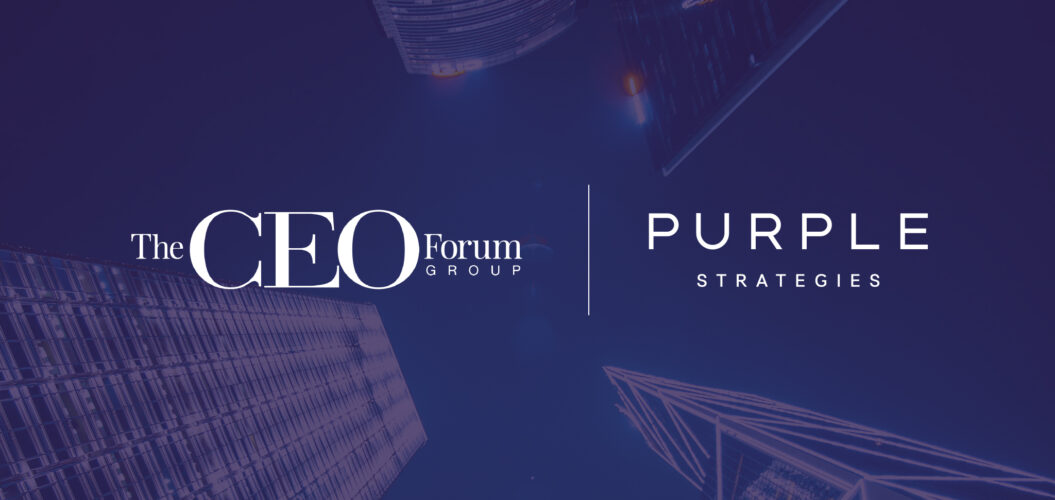
Posted on
June 23, 2023
3 Min. Read
Author
Purple Strategies
Prioritizing Purpose in the New Era of Capitalism
Five Insights from CEOs at the Third Annual Transformative CEO Summit
Purple Strategies is the thought leadership partner of The CEO Forum Group and Transformative CEO Summit series, featuring CEOs of leading companies discussing creative ways to solve today’s most pressing challenges.
Millennials and Gen Z are increasingly choosing to buy from companies that align with their values, just as employees seek meaning in their professions. These ideas both connect to the idea of companies’ purpose – and they are not new. But the new era of capitalism, in which companies prioritize many stakeholders (and not just shareholders), was on the minds of several top executives and CEOs at The CEO Forum Group’s third Annual Transformative CEO Summit in March.
Their conclusion? Prioritizing their purpose to serve multiple stakeholders in addition to making profits enables companies to survive challenging circumstances and thrive in changing conditions.
In our role as thought leadership and polling partner of the CEO Forum and the Summits, Purple Strategies identified five insights from CEO discussions during the Summit that explain how purpose plays a more vital role than ever in how executives lead their businesses.
1) Purpose is about more than creating a good—it’s about delivering stakeholders a greater good.
In a Summit poll, CEOs universally (97%) agreed that changes are needed to make capitalism work for all stakeholders.
Companies want to find ways to add value to all their stakeholders, including communities, Genpact CEO Tiger Tyagarajan said, adding that this stakeholder mindset attracts employees and adds long-term value to shareholders. Genpact helps global companies undergo transformation.
For shareholders, the primary purpose of a company certainly is profit. But to maintain long-term profitability and build an organization for the future, transformative CEOs maintain that companies must create a mission-driven culture, be empathetic and authentic with their employees, maintain open communication with suppliers, help communities through philanthropic initiatives, and communicate the intangible value of the goods and services they provide to customers.
For Ravi Saligram, CEO of Newell Brands, the company’s purpose isn’t just about manufacturing a new Sharpie color or Yankee Candle scent. It’s about bringing joy, confidence and peace of mind to customers. The purpose of GE Aviation Services is to invent the future of flight, lift people up and bring them home safely, its CEO Russell Stokes said. For business magnate Lynn Tilton, former CEO of MD Helicopters, the military helicopter manufacturing company’s purpose is to serve those who served for the love of country.
2) Purpose unlocks employees’ passion so that they become the company’s “secret sauce.”
When employees feel that they are going to more than a job and that they have a stake in the business, they will perform miracles and create long-term shareholder value. To affect this result, leaders must treat employees like they are the company’s “secret sauce,” Saligram said. Others agree on the need to prioritize employee belonging.
“I’d rather have B players that drive the right culture, the right attitude and the right leadership than a team of A players with their own selfish attitudes,” Xerox CEO Steven Bandrowczak said.
A simple but unifying purpose can galvanize these needle-movers within the company, which in turn turbocharges productivity and innovation.
3) Purpose is the “North Star” that guides leadership through change.
CEOs agree that they need to lean into the company’s “North Star” when external factors force them to change. For example, companies have been grappling with the benefits and drawbacks of artificial intelligence and machine learning. While it allows them to simplify their supply chains and processes, thereby reaching their goals faster, there are potential pitfalls such as losing human connection. When thinking about how to reckon with those tradeoffs, CEOs look to their purpose to guide them.
When leaders face issues, from the COVID-19 pandemic to inflation to the Russia-Ukraine War, companies must rely on their “North Star.”
4) To further the company’s purpose, leaders need to communicate with empathy, transparency and authenticity.
Empathy is understanding how people see the world, not just how they feel. That has widespread effects on how CEOs run their businesses. CEOs must keep this in mind when communicating, for example, the impact technology has on employees in their organizations and communities at large. While technology pushes organizations to operate more efficiently, human relationships keep them running like well-oiled machines.
To that end, leaders must communicate with empathy when explaining not only the purpose and goals of technological changes, but also how those changes will personally affect employees and benefit the team (and not create winners and losers). And because thinking about goals as opposed to thinking about people activates a different part of the brain, leaders must mindfully communicate their vision with understanding.
“CEOs must be real and not appear artificial because people respond to realness, which is underused in a time of crisis,” Dr. Stephen Klasko, former CEO of Jefferson Health, said.
5) Leaders must leave their ivory towers to understand how the public views their purpose.
Purpose weaves through the fabric of an organization, not just in the C-Suite. To understand how purpose is perceived and acted upon within companies, transformative CEOs say leaders need to seek out the view beyond the corner office.
In addition to reviewing numbers and spreadsheets, leaders must walk the halls and get out in communities to fully grasp how their business is doing. This qualitative information will help their businesses better align with their customers’ values and needs.
Often, executives will hear things on the ground that might not show up in reports. CEOs can gather feedback to see if they are fulfilling their purpose, and if there are any discrepancies or omissions, they can alter the company’s course. Xerox, for example, hosts small town halls to understand how they are doing. Bigelow Tea has a State of the Union with employees every three to four months where CEO Cindi Bigelow shares her appreciation for her employees, conveys the importance of community over self, and talks about the company’s success.
A company’s purpose affects how it operates: from hiring and retaining the best talent, to motivating younger employees, to fostering a hustle culture, to propelling through uncertainty. Prioritizing customers, unlocking employees’ passion, maintaining principles, communicating with empathy, and leaning into purpose during times of change will help companies be successful in the new era of stakeholder capitalism.
Explore more from Purple Strategies in the Transformative CEO Summit series:
CEOs Pivot From Health Crisis To Human Connection | 2021 (Read)
CEOs Strive To Build A Better Workplace Post-Pandemic | 2021 (Read)
CEOs Share Views On ESG Challenges And Opportunities | 2021 (Read)
CEOs Embrace Expectation To Go Beyond Corporate Into Societal Leadership | 2022 (Read)
CEOs Foster The Dynamic Pull At The Heart Of Breakthrough Innovation | 2022 (Read)
CEOs Unleash The Power Of The Individual | 2022 (Read)
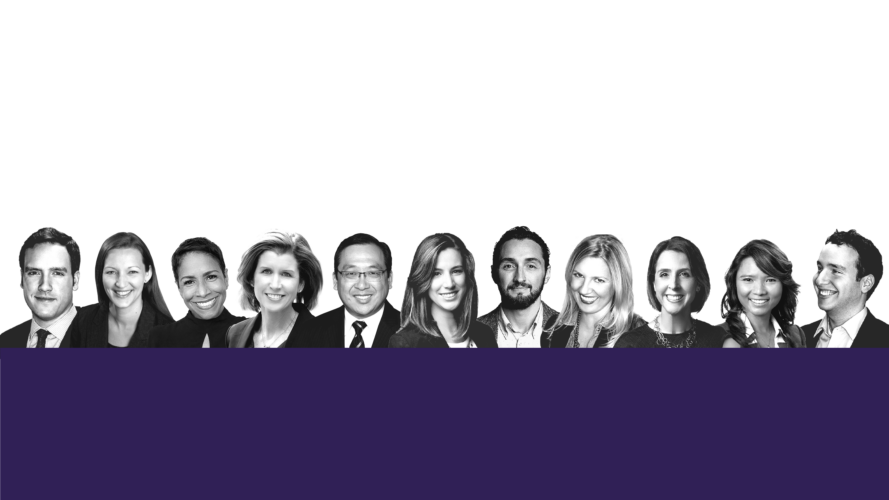
Posted on
June 2, 2023
2 Min. Read
Author
Purple Strategies
Purple Strategies Expands Leadership Structure Strengthening Expertise Focus And Operational Scale
The firm has tapped experienced Purple leaders and executive-level additions for key appointments and new roles in support of its people, clients and continued growth.
Solidifying the structure of the organization to support continued dynamic growth has been a key priority for Purple Strategies in recent years. The firm announced today several key appointments and new roles to help Purple efficiently grow and develop during its next chapter.
“As we approach our 15th year as Purple, having grown from a small startup to a firm of 150 and growing, we’re intently focused on maintaining the density of talent and the collaborative culture that has been the foundation of the deep client partnerships we’ve built,” said Kristen Morgante, Purple Strategies Managing Partner and COO. “Over the past two years we’ve been thoughtful in working through how we can scale what makes Purple so special to fit not just the size we are now but also the firm we’ll be three, five and even 10 years into the future. The new structure we’ve created, organized around expertise, will allow us that freedom to scale. And we are exceedingly fortunate to have a cohort of talented leaders who are passionate about Purple stepping into new roles and helping to bring this reimagined Purple to life.”
Leading the firm’s new expertise groups are some of Purple’s most gifted and seasoned strategic leaders: Nate Byer, Client & Campaign; Crystal Benton, Communications; Jillayne Smyth-Rogers, Creative, Content & Production; Bradley Engle, Paid & Audience Solutions; Denise Brien, Research; and Stephen Smith, Strategic Planning. These leaders will guide development of Purple team members and Purple thinking alongside their client leadership roles.
“CEOs and other executives turn to Purple as partners in navigating growth, change and challenges, knowing our unique approach and deep bench of reputation strategists will help them and their companies be their best selves,” said Steve McMahon, Purple Strategies CEO. “Our newly defined expertise groups, with the guidance of these Purple leaders, will help ensure our unique Purple thinking continues to drive our work and client offerings as we grow.”
Purple’s leadership is also being strengthened with key appointments in operations, including three new additions to the firm. Colleen Connors, who comes to Purple most recently from The ONE Campaign where she was Chief Talent Officer, and prior to that was Executive Vice President, Global Talent, for Porter Novelli, has joined the firm as its first Chief People Officer. Ben Seto, most recently CFO of the American Petroleum Institute and before that CFO of Ankura Consulting Group, joins the firm as Chief Financial Officer. Jackie Le, joining Purple from accounting roles in an AM Law 100 firm, is the firm’s new Controller. In an internal move, Purple managing director Rebecca Ballard, who has led communications, marketing and engagement for the firm, has been named Purple’s first Chief of Staff. These appointments build on the firm’s recent announcement of veteran media and marketing executive Angela R. Bundrant as head of brand and business development.
“As part of our reimagining of Purple’s structure, we worked to build out the operations side of the organization to a level of talent and experience that could match the dynamic growth of our client work and expertise, and I’m so pleased we’ve been able to achieve that,” Morgante said.

Posted on
June 2, 2023
1 Min. Read
Author
Purple Strategies
Purple Strategies Welcomes Colleen Connors As First Chief People Officer
Colleen Connors, a thoughtful, creative and transformational people and talent management leader, has joined Purple Strategies as its first Chief People Officer. She brings extensive experience leading organizations through growth and ensuring people and business strategies align.
“What makes Purple such a special place to work on some of the world’s toughest challenges is the people – I would choose this team every time – which is why we’re so excited to have Colleen here with us and creating this new role,” said Kristen Morgante, Purple Managing Partner and COO. “Her passion for the employee experience and skill at developing strong teams and leaders makes her a perfect addition to Purple at this stage in our journey and an asset to each and every one of us at Purple.”
Colleen joined Purple from The ONE Campaign, a global campaigning organization to end extreme poverty and preventable disease, where she was the Chief Talent Officer and worked with colleagues across nine countries. Prior to ONE, Colleen served as the Executive Vice President, Global Talent, for Porter Novelli, a public relations agency, where she integrated talent functions to deliver more efficient HR solutions, aligned with the organizational structure.
A former communications director and human rights campaigner, Colleen holds a BA in Political Communication from The George Washington University.
“It is a privilege to join Purple Strategies, especially at this important and exciting time of rapid growth,” Connors said. “I was immediately struck by the abundance of talent, collaboration and innovation across every team, and I’m energized by the opportunity to help shape how we center, support and empower our people through their careers.”

Posted on
June 2, 2023
1 Min. Read
Author
Purple Strategies
Ben Seto Joins Purple Strategies As CFO
Purple Strategies has welcomed Ben Seto, most recently Vice President and Chief Financial Officer of the American Petroleum Institute (API), as CFO.
“As Purple continues to navigate a chapter of dynamic growth, having the guidance and partnership of a financial leader of Ben’s caliber is a tremendous asset,” said Kristen Morgante, Purple Managing Partner and COO. “The other partners and I are pleased to have him with us as we chart the course ahead for Purple.”
At API Seto was responsible for financial operations, budget management, and aligning financial performance with strategy. Prior to Seto was CFO of Ankura Consulting Group, a management consulting company that has grown rapidly organically and thru acquisitions. During his tenure at Ankura, Seto integrated the finance team, implemented new systems, and standardized financial and business processes to position the firm for further acquisitions. Seto also oversaw the IT function.
Prior to Ankura, Seto was CFO for Avendra, a procurement services company. Seto oversaw the finance function, and collaborated on growth strategies and M&A. Earlier in his career, Seto served in senior financial leadership roles in publicly traded and privately held companies in the professional services, energy, technology, financial services and consumer products industries.
Seto holds an MBA in Finance & Accounting from the William E. Simon Graduate School of Business Administration, and a BA in Economics from the University of Rochester.
“Between the impressive team Purple has assembled and the unique work the firm is doing in the corporate reputation space, it’s easy to understand why Purple is on such a growth trajectory,” Seto said. “That road from startup to scale offers real opportunity to make an impact from a finance perspective and I’m excited to join the Purple team on that journey.”

Posted on
June 2, 2023
1 Min. Read
Author
Purple Strategies
Purple’s Rebecca Ballard Named Firm’s First Chief of Staff
Purple Strategies has tapped Rebecca Ballard, who has been leading communications, marketing and engagement for the firm since joining Purple as a managing director in 2020, to be Purple’s first Chief of Staff. The appointment comes as Purple expands its leadership structure in support of its people, clients and continued growth.
“Rebecca seems like she has always been Purple, for the many ways she works in partnership with me and the other partners, leads our operations team, and supports and encourages Purple as a whole,” said Kristen Morgante, Purple Managing Partner and COO. “This new chief of staff role is a natural extension for her and for Purple and will be incredibly beneficial to the firm as we grow and transform within our new structure.”
Before coming to Purple, Ballard was a communications and operations executive at Hill+Knowlton Strategies, a global communications consultancy and public relations network. During her time with the firm she served in a series of roles that included leading the firm’s Washington, D.C., office, leading communication and culture for the firm’s U.S. operation, and partnering with the firm’s top leaders on culture, growth and transformation priorities. Ballard began her career at Public Strategies, a business advisory firm specializing in public affairs, crisis management and public opinion research. Her work with the firm for nearly a decade covered a broad spectrum of industry sectors, including automotive, retail, manufacturing, health care, energy, and financial and professional services.
“Purple has been such an exciting and dynamic place to be since my day one, and I’m grateful to have been working alongside some truly talented people through a period of extensive change and growth for our clients and for our firm,” Ballard said. “That story for Purple continues. And with Colleen [Connors], Ben [Seto], Angela [Bundrant] and others joining the Purple team, and the persistent brilliance of the team I joined three years ago, there’s never been a better time to be Purple.”
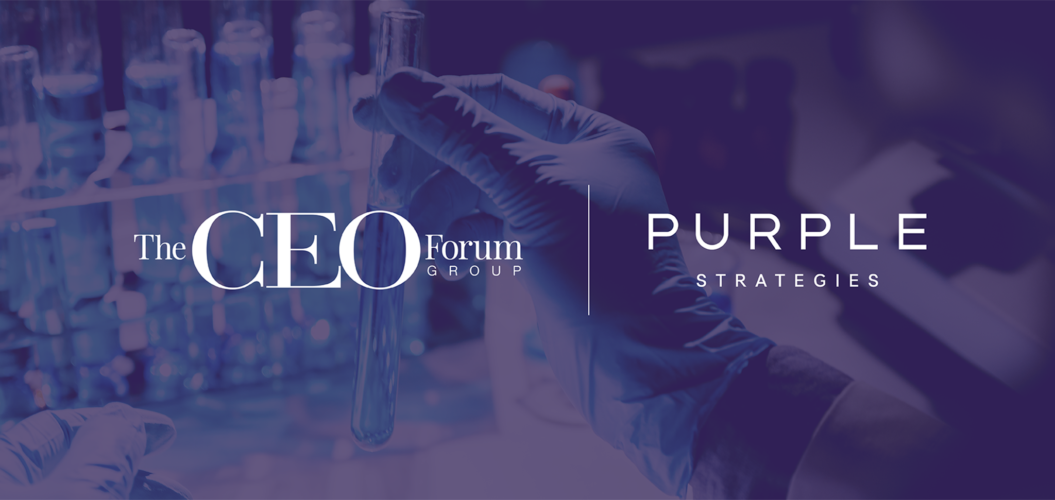
Posted on
May 8, 2023
3 Min. Read
Author
Purple Strategies
A Post-Pandemic Renaissance in Health
Three ways the COVID-19 pandemic has brought a renaissance in healthcare
Purple Strategies is the thought leadership partner of The CEO Forum Group and Transformative CEO Summit series, featuring CEOs of leading companies discussing creative ways to solve today’s most pressing challenges. The Transformative CEO Healthcare Summit brought together CEOs in the healthcare industry to explore how technology is transforming healthcare and wellness, the healthcare supply chain, fighting human trafficking, and the future of care delivery.
Robert Reiss, founder and CEO of The CEO Forum Group, opened December’s Transformative CEO Summit with a hopeful possibility for our future: that our collective recovery from this devastating global pandemic will bring the emergence of a new renaissance in healthcare.

Just as Europe emerged from the devastation of the bubonic plague to embrace wide-ranging cultural, economic, and social changes, the world has responded to the pandemic in profound ways, including, notably, rapid transformations within our healthcare industry that are likely to leave a lasting positive impact for generations to come.
Summit participants discussed three ways the COVID-19 pandemic has ushered in a healthcare renaissance – one that puts us on a path to better health outcomes and greater efficiency.
(1) Accelerated healthcare innovation
The Renaissance era saw a rapid advancement of new technologies – from the invention of the printing press and telescope to the widespread adoption of eyeglasses – that put humanity on a new path forward. Similarly, today’s healthcare environment has seen disruptive new health technologies emerge and accelerate under the conditions created by the pandemic.
An obvious example is the COVID-19 vaccine, an unprecedented achievement not just for the creation of revolutionary new mRNA technology, but also for its rapid development and deployment to billions around the world. However, Summit participants pointed to potentially an even greater technological triumph – the development and adoption of artificial intelligence (AI) and machine learning (ML) in the healthcare space. Throughout the pandemic, healthcare organizations embraced these tools to identify inefficiencies in processes and resource allocation, forecast disease outbreaks, predict health risks, and more. The ability of AI and ML to harness data in new ways – by unlocking insights and making data more useful – has already had a big impact on preventative medicine that will only continue to grow.
(2) New norms for patient care
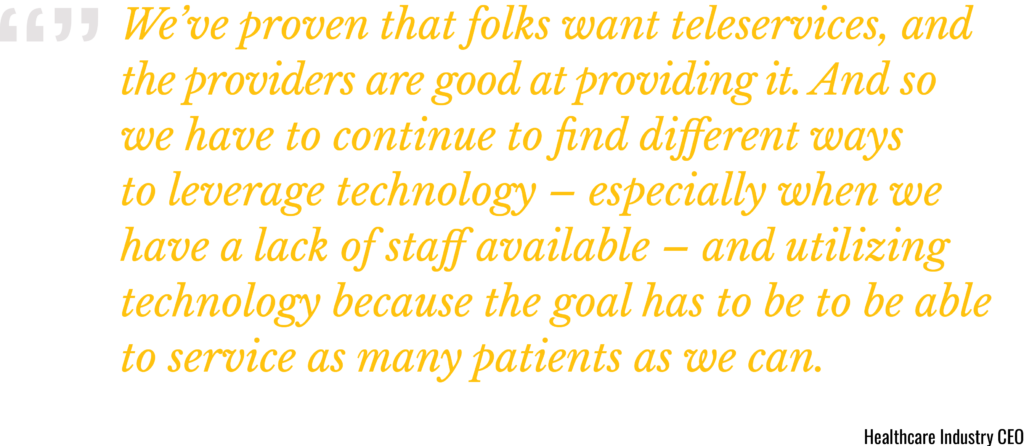
Telemedicine has been growing for some time, but social distancing and the restrictions on in-person visits during the pandemic hastened widespread adoption. The considerable benefits of telemedicine experienced during the pandemic – from helping reduce the burden on overwhelmed hospitals and other healthcare facilities, to allowing healthcare providers to triage patients more effectively to ensure those in need of in-person care are seen more quickly – have helped make the case that telemedicine is here to stay. This trend toward remote care delivery could define the future of healthcare, although Summit participants acknowledged short-term headwinds as government and insurance industry support have decreased as pandemic conditions have improved.
(3) Uncommon healthcare partnerships and widespread sharing of ideas
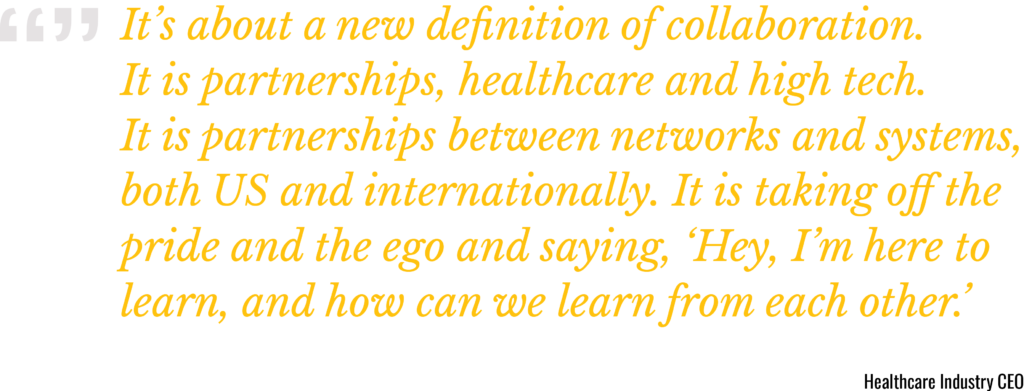
Summit participants agreed that the pandemic highlighted the importance of collaboration in the healthcare industry. The need for rapid solutions to the crisis led to a surge in research and development that required unprecedented cooperation between pharmaceutical companies, government, and academic institutions to develop vaccines and treatments. Participants also noted the value of sharing data and medical information across organizations and borders to make new learning accessible quickly and optimize delivery of care to patients. Moreover, partnerships between technology companies and healthcare organizations have enabled numerous developments in the healthcare space – from the development of telemedicine platforms for hospitals, to technology startups focused on rapid test kit development. Maintaining this extraordinary level of collaboration between healthcare organizations, technology companies, academia and government will continue to be critical.
Is this health renaissance already coming to an end, or is it just beginning?

Summit participants expressed a shared optimism that a revival in healthcare may be emerging, but we can’t be certain it will endure. Even the immense progress we made with telemedicine during the pandemic may regress as government restrictions are lifted and insurance companies drop coverage. While the COVID-19 pandemic was a powerful catalyst for rapid technological innovation, deep social and cultural shifts, and a renewed spirit of collaboration within the healthcare industry, leaders within the healthcare space must keep up the momentum in order to achieve long-lasting, meaningful impact for humanity and the future of our health.
 CEOs Embrace Risk to Reveal Courage in the Face of Change
CEOs Embrace Risk to Reveal Courage in the Face of Change  Purple Strategies Elevates Three To Partnership Group
Purple Strategies Elevates Three To Partnership Group